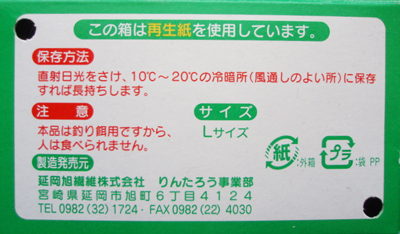100 Stories1977 Rintaro Earthworms
“Asahi Kasei’s Business Idea, Raising Earthworms Is a Big Hit—This Year’s Sales Are Expected to Reach 300 Million Yen”
This headline was once in the newspaper. The sales of the earthworm raising business that Nobeoka Asahi Senni started were smoothly increasing.
The idea behind it was innovative. It effectively utilized the fiber scraps, which are a by-product of manufacturing Bemberg™, to raise earthworms that are used as bait. Since it uses fiber scraps, it was named Rintaro after the word “Cotton linter (pronounced Rinta in Japanese).”
Rintaro was raised as bait and was launched in 1977. Each box contained about 60 earthworms (about 30 grams in total), and its retail price ranged from 250 to 300 yen. They came in three sizes: big, normal-sized, and small worms. The retail price-based sales in the first fiscal year were approximately 50 million yen and they continued to increase every year. Riding the crest of the fishing trend, the company shipped 58.7 tons in its heyday in 1988, making it a major producer that accounts for about 50 percent of the national market share.
One of the reasons Rintaro was a success was how active it is. Normal earthworms live for about a week of packaging, while Rintaro came with a one-month guarantee. It is surprising to hear that they actually live for two to three months. The main ingredient, cotton linter, the soil inside the box, and the packaging method had the company’s unique ideas applied to them.
Rintaro continued to perform well, but it was later swayed by the current of the times. In addition to economic recess, artificial bait, such as fishing lures, became popular, decreasing the shipments to a quarter.
“Will we have to discontinue it?” Around that time, it was discovered that the enzymes of earthworms dissolve blood clots. A pharmaceutical company in Nara Prefecture ordered them in bulk as an ingredient for health foods. Their demand continued to increase with the aging population and health trends, outperforming the bait earthworms.
In 2001, 15 farmers were commissioned to raise them. The amount shipped annually recovered to 42 tons (30 tons of which were for health foods), and the demand kept surpassing the supply. Their feces are porous like activated charcoal and have deodorizing effects, so they were test marketed as potting soil.
After hearing about the popularity of the earthworms, many people and companies wanted to learn how to raise them. However, the company warned them that it was not a profitable business if invested in separately. Earthworms are delicate creatures. Increasing equipment does not necessarily increase production. They have to stay hydrated at a temperature between 15 and 25 degrees. Nutrition is also key. Aside from cotton linter, they have to be fed vegetables and mushroom cultivation substrate. If the environment is not suitable for them, they can escape in groups. It is not rare to arrive at work in the morning to find the earthworms had escaped overnight. Raising earthworms takes a lot of time and effort.
They are just earthworms, but they are still important. The earthworm business started with an innovative idea and effective utilization of waste, representing Asahi Kasei’s unique creative thinking and environmental awareness.
 Rintaro’s package
Rintaro’s package


